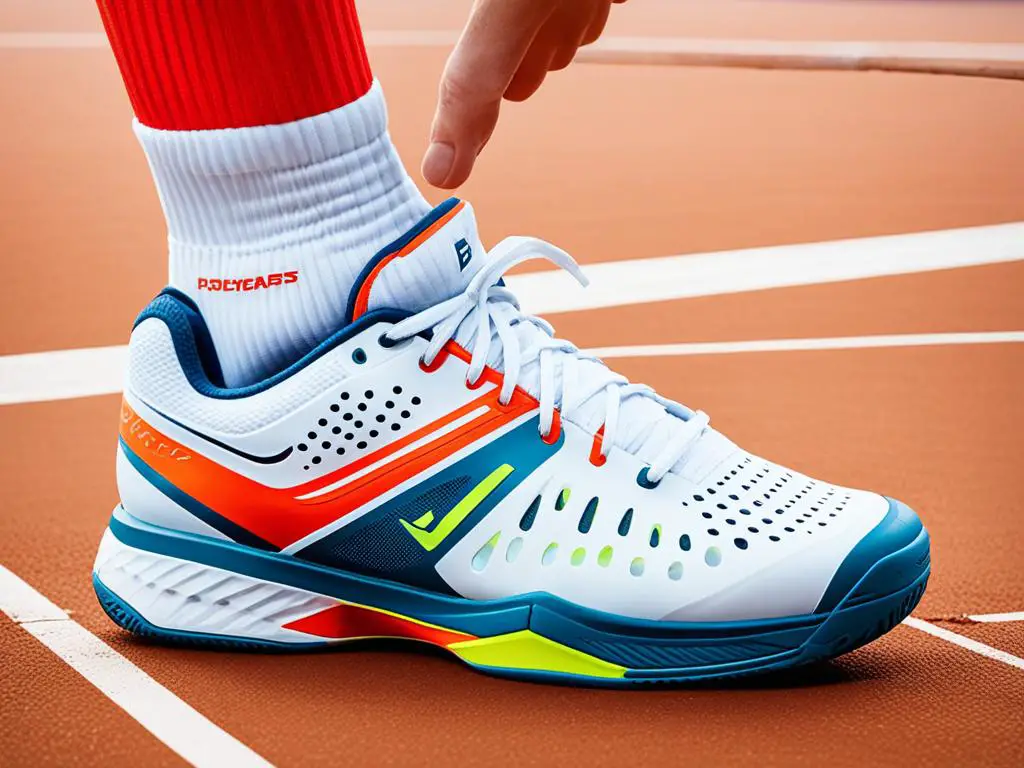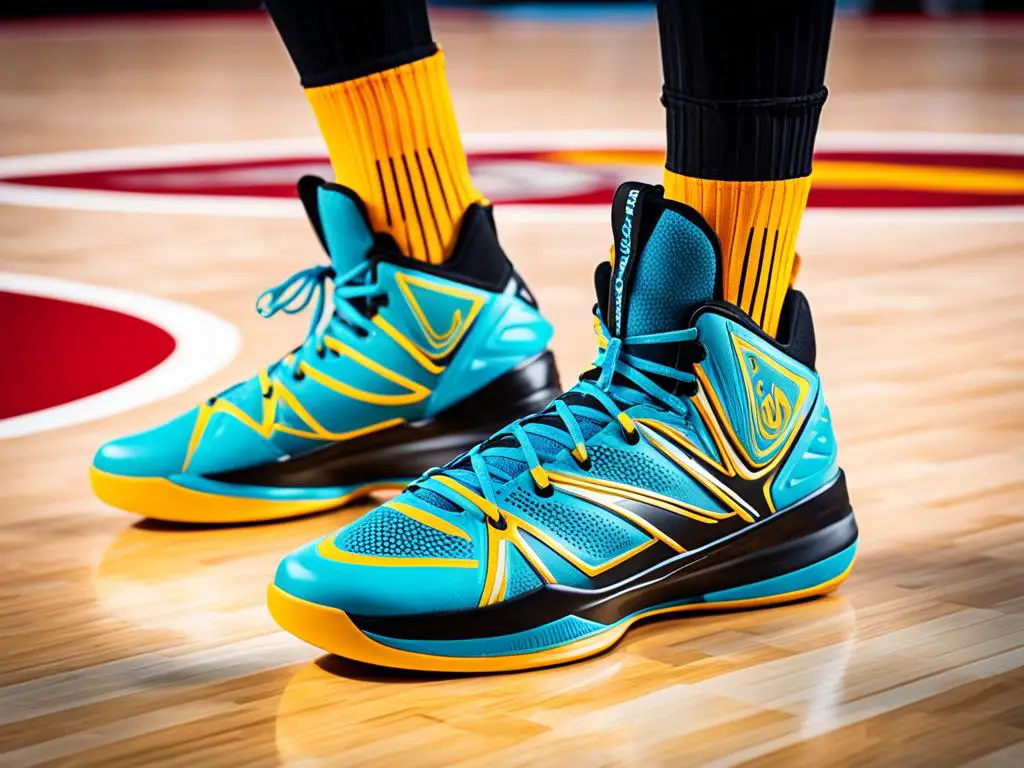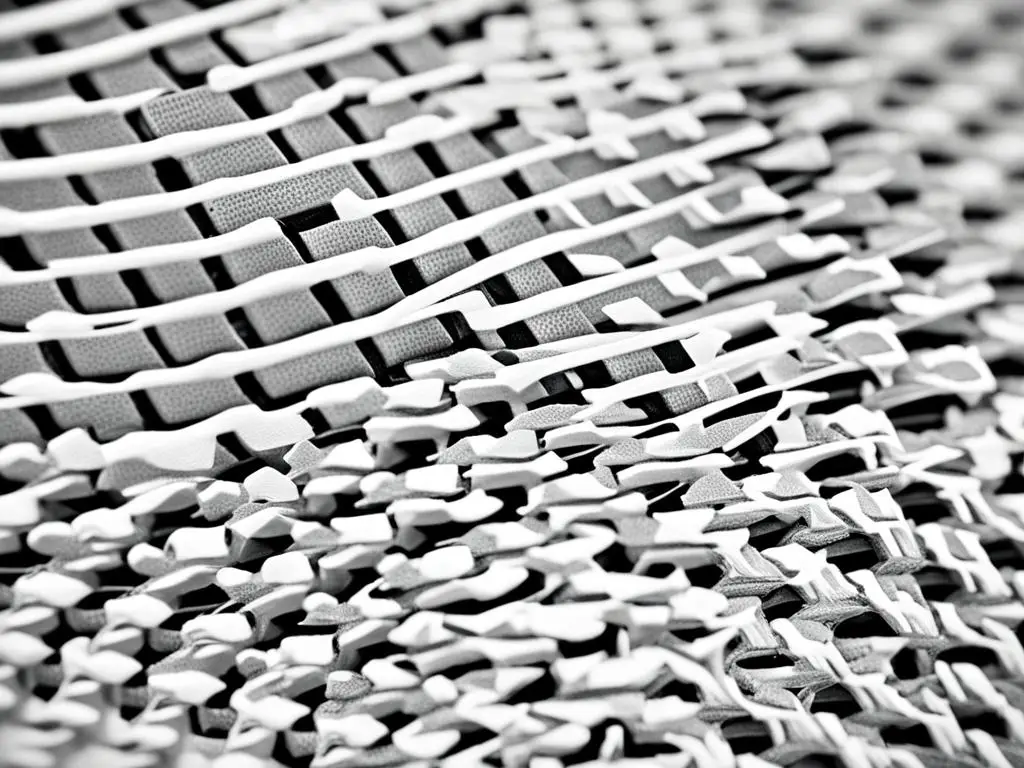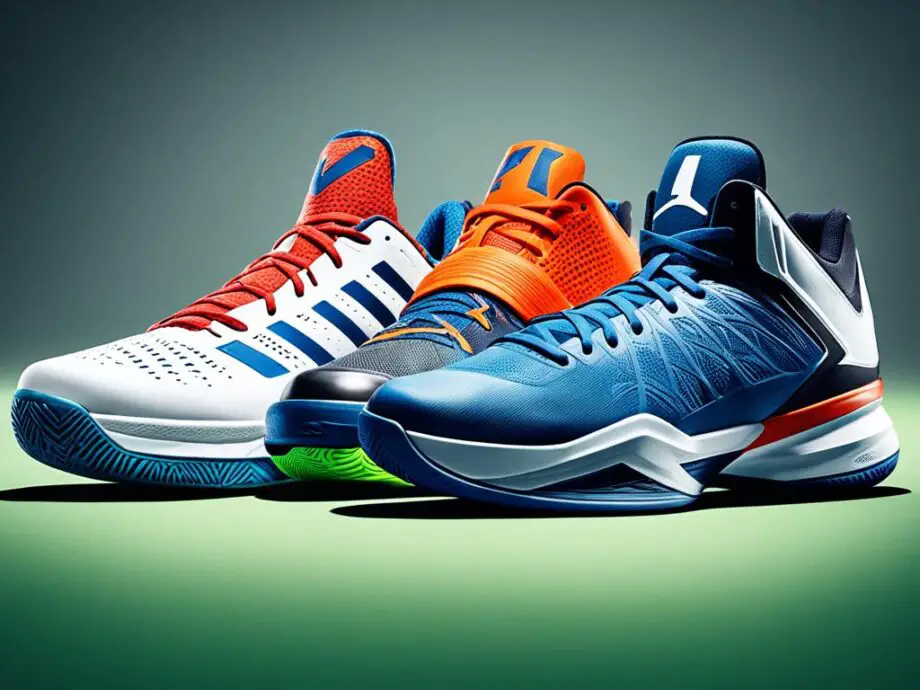When it comes to choosing athletic footwear for court sports, such as tennis or basketball, it’s important to understand the differences between tennis shoes and basketball shoes. The right pair of shoes can enhance your performance, provide necessary support, and help prevent injuries. In this article, we will compare and contrast the key features of tennis shoes and basketball shoes, helping you make an informed decision when selecting the best footwear for your court needs.
Key Takeaways:
- Tennis shoes and basketball shoes are designed with specific performance factors and construction features to cater to the demands of each sport.
- Tennis shoes prioritize agility, stability, and traction, while basketball shoes focus on vertical movements, cushioning, and ankle support.
- When buying athletic footwear, consider the court sport you’ll be playing, and choose shoes that provide the necessary comfort, support, and traction for that particular sport.
- Understanding the key differences between tennis shoes and basketball shoes can help you optimize your performance and reduce the risk of injuries on the court.
- Make an informed decision when selecting athletic footwear by considering the specific requirements of your sport, and prioritize functionality over aesthetics.
Performance Factors: Tennis Shoes
When it comes to choosing athletic footwear for tennis, there are specific performance factors that come into play. Tennis shoes are designed with the unique requirements of the sport in mind, offering various features that enhance performance on the court.
One of the key factors that sets tennis shoes apart from basketball shoes is their focus on agility. Tennis players need to be quick on their feet, making swift movements in all directions. Tennis shoes are designed to provide excellent maneuverability, allowing players to change direction rapidly without compromising stability.
Tennis matches involve a lot of lateral movements, such as side-to-side shuffles and quick bursts of speed. To support these movements, tennis shoes offer enhanced stability. They feature reinforced midsoles and lateral support systems that help prevent rollover and provide stability during aggressive lateral motions.
Another performance factor that sets tennis shoes apart is their exceptional traction on the court. Tennis shoes are equipped with specialized outsoles that feature herringbone or modified herringbone patterns. These patterns are designed to deliver optimal grip and traction on different court surfaces, allowing players to make quick stops and start movements.
Overall, tennis shoes are specifically engineered to optimize performance on the tennis court. Their focus on agility, stability, and traction ensures that players can move swiftly, maintain balance, and change direction quickly without compromising their footwork.

Performance Factors: Basketball Shoes
When it comes to basketball, having the right footwear can significantly impact your performance on the court. Basketball shoes are designed with a specific focus on the movements and demands of the game. Their features are geared towards enhancing vertical jumps, providing cushioning to protect against high-impact landings, and supporting quick cuts and change of direction on the hardwood.
One of the key performance factors of basketball shoes is their ability to facilitate vertical movements. Whether it’s going for a layup, dunking the ball, or blocking shots, basketball players rely on explosive jumps and great leaping ability. Basketball shoes are equipped with cushioning technologies, such as airbags or foam, in the midsole to provide superior shock absorption and protect the feet during high-impact landings.
The outsole of basketball shoes also plays a crucial role in performance on the court. It is designed with specific patterns and materials to provide excellent traction, allowing players to make quick cuts, stop suddenly, and maintain stability during intense gameplay. The grip and traction offered by basketball shoes are essential for preventing slips and ensuring precise footwork.
Additionally, basketball shoes often feature higher collars that extend above the ankle. These high-top designs provide extra support and stability to the ankles, reducing the risk of sprains or injuries during aggressive play. The added ankle support allows players to confidently make quick movements, change direction swiftly, and protect against accidental collisions.
Overall, basketball shoes are engineered to enhance performance by providing the necessary support, cushioning, and traction needed for the dynamic nature of the game. They prioritize vertical movements, protection against high-impact landings, and superior stability during quick cuts and directional changes.
| Performance Factors | Basketball Shoes | Tennis Shoes |
|---|---|---|
| Vertical Movements | ✅ | ❌ |
| Cushioning | ✅ | ✅ |
| Quick Cuts and Directional Changes | ✅ | ✅ |
| Ankle Support | ✅ | ❌ |
As seen in the table above, basketball shoes excel in vertical movements, cushioning, quick cuts, and directional changes, as well as ankle support when compared to tennis shoes. However, this does not mean that basketball shoes are entirely unsuitable for other sports. They can still be used for various athletic activities, but their design and features are optimized for the specific needs of basketball players.
Now that we have explored the performance factors of basketball shoes, let’s move on to the next section, where we will discuss the construction and design aspects specific to tennis shoes.

Construction and Design: Tennis Shoes
Tennis shoes are meticulously designed to meet the specific requirements of playing on a tennis court. The construction and design elements play a crucial role in enhancing performance, providing comfort, and ensuring durability during intense matches. Let’s explore the key features that make tennis shoes the ideal choice for tennis enthusiasts.
1. Durable Outsoles
The outsoles of tennis shoes are engineered to withstand the abrasive court surface and provide exceptional traction. The unique tread patterns and durable rubber materials offer excellent grip and allow players to move swiftly across the court. The design of the outsoles ensures stability during lateral movements, preventing unnecessary slips and falls.
2. Supportive Midsoles
Tennis involves quick and explosive movements, including sudden stops, pivots, and side-to-side motions. To support these actions, tennis shoes are equipped with supportive midsoles that provide cushioning and shock absorption. The midsoles help reduce the risk of injuries by absorbing the impact of harsh landings and providing stability during aggressive play.
3. Breathable Uppers
Tennis matches can be physically demanding, resulting in excessive sweating and heat buildup within the shoe. Breathable uppers in tennis shoes allow for adequate airflow, keeping the feet dry and comfortable throughout the game. Mesh materials and ventilation systems effectively dissipate heat, preventing discomfort and potential foot conditions caused by excess moisture.
By prioritizing durable outsoles, supportive midsoles, and breathable uppers, tennis shoes offer the perfect combination of performance, comfort, and longevity. Whether you’re a recreational player or a professional athlete, investing in high-quality tennis shoes is essential for optimizing your game on the court.

Stay tuned for the next section, where we will delve into the construction and design of basketball shoes, highlighting their unique features that cater to the dynamic demands of the basketball court.
Construction and Design: Basketball Shoes
In the world of athletic footwear, basketball shoes offer distinct features that cater to the dynamic demands of the basketball court. These shoes are specifically designed to prioritize ankle support, cushioning, and stability, enabling players to execute quick movements and play with aggression.
When it comes to basketball shoe construction, brands like Nike, Jordan, and Adidas invest heavily in research and development to incorporate innovative technologies that enhance performance. The design elements provide the necessary support and comfort for players during intense games.
One of the key components of basketball shoe design is ankle support. These shoes often feature a higher collar or built-in straps that provide stability and reduce the risk of ankle injuries. The heightened support offers players the confidence to make explosive moves on the court without compromising their safety.
Cushioning is another crucial aspect of basketball shoe construction. The midsole is equipped with responsive foam or air units that absorb the impact of jumps and landings, minimizing the strain on the player’s joints. This cushioning technology allows for a higher level of comfort and reduces the risk of fatigue during prolonged games.
Stability is paramount in basketball shoes, as players engage in frequent lateral movements, cuts, and changes of direction. The outsole of basketball shoes often features multidirectional patterns and durable rubber compounds that provide excellent traction on the court. The enhanced grip allows players to make quick and precise movements, maintaining control and stability.
Overall, basketball shoe construction and design prioritize the unique requirements of the sport. With a focus on ankle support, cushioning, and stability, these shoes are tailored to the dynamic nature of basketball, enabling players to perform at their best.
| Construction and Design | Tennis Shoes | Basketball Shoes |
|---|---|---|
| Ankle Support | Lower collar, less emphasis on ankle support | Higher collar, built-in straps for superior ankle support |
| Cushioning | Responsive cushioning for impact absorption | Midsole with responsive foam or air units for enhanced cushioning and shock absorption |
| Outsole | Durable outsole with tennis-specific patterns for traction on different court surfaces | Outsole with multidirectional patterns and durable rubber compounds for excellent traction on the basketball court |
| Design | Focus on durability, breathability, and lateral support | Emphasis on ankle support, stability, and multidirectional movements |
| Key Features | Durable outsoles, supportive midsoles, breathable uppers | Ankle support, responsive cushioning, excellent traction |
Key Differences and Similarities
In this section, we will compare and contrast the key differences and similarities between tennis shoes and basketball shoes. Whether you’re a tennis player or a basketball enthusiast, understanding the distinctions between these two types of sports footwear is essential for optimal performance on the court.
Differences
Let’s start by examining some of the core differences between tennis shoes and basketball shoes:
- Outsole Patterns: Tennis shoes typically have herringbone or modified herringbone patterns on the outsole, providing excellent traction and stability on the tennis court. On the other hand, basketball shoes often feature multidirectional patterns or circular patterns to support quick lateral movements and pivots on the basketball court.
- Cushioning Technologies: Tennis shoes prioritize cushioning in the heel and forefoot areas to aid in shock absorption and ensure a comfortable stride. In contrast, basketball shoes offer enhanced cushioning throughout the entire midsole to protect against high-impact landings from jumps and aggressive movements.
- Ankle Support: Tennis shoes generally provide moderate ankle support to allow for more flexibility and movement on the court. On the contrary, basketball shoes are designed with higher collars or supportive overlays to prevent ankle injuries during lateral movements and jumps.
- Weight: Tennis shoes tend to be lighter in weight to facilitate quick movements and agility, whereas basketball shoes may have added cushioning and support features that make them slightly heavier.
Similarities
Despite the differences, there are also some similarities between tennis shoes and basketball shoes:
- Both tennis shoes and basketball shoes are crafted with durable materials and reinforced toe caps to withstand the demands of court sports and provide long-lasting performance.
- Both types of shoes incorporate breathable uppers to promote ventilation and maintain foot comfort during intense gameplay.
- Both tennis shoes and basketball shoes offer various designs, colors, and styles to cater to different player preferences and fashion trends.
To help you visualize the differences and similarities between tennis shoes and basketball shoes, refer to the table below:
| Features | Tennis Shoes | Basketball Shoes |
|---|---|---|
| Outsole Patterns | Herringbone or modified herringbone patterns | Multidirectional or circular patterns |
| Cushioning Technologies | Cushioning in the heel and forefoot | Enhanced cushioning throughout the midsole |
| Ankle Support | Moderate ankle support | Higher collars or supportive overlays |
| Weight | Lightweight | Slightly heavier |
| Durability | Durable materials and reinforced toe caps | Durable materials and reinforced toe caps |
| Breathability | Breathable uppers | Breathable uppers |
| Design Options | Various designs, colors, and styles | Various designs, colors, and styles |
By understanding these differences and similarities, you can make an informed decision when selecting the right footwear for your specific court sport requirements. Keep in mind that personal preference and individual playing style are crucial factors to consider when making your choice. Take advantage of athletic shoe reviews and seek advice from experts to find the perfect pair of sports shoes that will elevate your performance on the court.
Conclusion
In conclusion, when it comes to optimizing your performance on the court, choosing the right athletic footwear is crucial. Whether you are playing tennis or basketball, understanding the specific performance factors, construction, and design of each shoe type will help you make an informed decision.
For tennis players, prioritize shoes that enhance agility, provide stability during lateral movements, and offer excellent traction for quick direction changes on the court. Look for durable outsoles, supportive midsoles, and breathable uppers to ensure comfort and longevity.
On the other hand, basketball players should focus on shoes that offer superior ankle support, cushioning, and stability to facilitate jumping, cutting, and comfortable landings. Consider shoes designed with a focus on vertical movements and protection against high-impact landings.
Regardless of your chosen sport, remember to prioritize comfort, support, and traction when selecting between tennis shoes and basketball shoes. When you have the right footwear, you can feel confident and perform at your best, taking your game to new heights.
